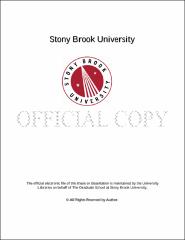| dc.identifier.uri | http://hdl.handle.net/11401/77751 | |
| dc.description.sponsorship | This work is sponsored by the Stony Brook University Graduate School in compliance with the requirements for completion of degree. | en_US |
| dc.format | Monograph | |
| dc.format.medium | Electronic Resource | en_US |
| dc.language.iso | en_US | |
| dc.publisher | The Graduate School, Stony Brook University: Stony Brook, NY. | |
| dc.type | Thesis | |
| dcterms.abstract | Despite the evidence that C. torquata modifies the sedimentary habitat with respect to sediment permeability, porosity, oxygenation and organic matter content, few studies have examined their impact on the benthic community. The objective of this study was to determine if the marine polychaete Clymenella torquata affected certain biological parameters of the benthos surrounding their tubes, and how those parameters might change with C. torquata abundance. 100 total core samples were taken at two different study sites on the southern shore of Shinnecock Bay on either side of the tidal inlet. The benthic faunal contents of these cores were identified and counted, and reported as abundances per core. Chlorophyll-a samples were taken from the sediment several centimeters adjacent to the location of the sediment cores. Chlorophyll values were calculated as the amount in µg Chl-a cm-3 of surficial sediment. In total, 89 different species were identified across the two sites, with a sum of 49,697 individuals. Benthic species abundance data was used to calculate the community measures: species density, richness, diversity and community similarity. Species density increased with increasing C. torquata abundance, while species richness decreased. Diversity and community similarity demonstrated no decisive trend in relation to C. torquata abundance. Multiple regression analysis demonstrated that C. torquata was a significant predictor for all four community measures, as well as Chl-a density (p < 0.05). When considering the specifics of the effects of C. torquata abundance on species assemblages, ANOSIM analysis demonstrated that there was a significant difference in community composition dependent on the presence or absence of C. torquata (p < 0.001). There was a significant difference in community composition dependent on the level of C. torquata abundance (p < 0.001). There was a significant difference in community composition dependent on the level of Chl-a density (p < 0.001). Results suggest that standing stocks of surficial MPB are positively related to C. torquata; density increased with C. torquata abundance. Patterns of distribution of C. torquata, along with the size and longevity of C. torquata beds, indicate that there is a mechanism of intraspecific facilitation that occurs within the bed, by which community facilitation may be a by-product. Moderate to high densities of C. torquata are strongly associated with an increase in density of infaunal species, facilitated by the availability of the resources C. torquata modifies, certainly in regards to oxygen, but also potentially in the availability of organic matter. Based on the results of this study, it can be concluded that C. torquata does have a significant effect on the benthic infaunal community, most likely forming “hotspots†of density where certain species proliferate against a smaller consistent background assemblage. | |
| dcterms.available | 2017-09-20T16:53:30Z | |
| dcterms.contributor | Cerrato, Robert M | en_US |
| dcterms.contributor | Lopez, Glenn R | en_US |
| dcterms.contributor | Volkenborn, Nils. | en_US |
| dcterms.creator | Hildebrandt, Emily | |
| dcterms.dateAccepted | 2017-09-20T16:53:30Z | |
| dcterms.dateSubmitted | 2017-09-20T16:53:30Z | |
| dcterms.description | Department of Marine and Atmospheric Science | en_US |
| dcterms.extent | 68 pg. | en_US |
| dcterms.format | Monograph | |
| dcterms.format | Application/PDF | en_US |
| dcterms.identifier | http://hdl.handle.net/11401/77751 | |
| dcterms.issued | 2017-05-01 | |
| dcterms.language | en_US | |
| dcterms.provenance | Made available in DSpace on 2017-09-20T16:53:30Z (GMT). No. of bitstreams: 1
Hildebrandt_grad.sunysb_0771M_13337.pdf: 1664317 bytes, checksum: e7494354033f128a41b7449a3bbb6239 (MD5)
Previous issue date: 1 | en |
| dcterms.publisher | The Graduate School, Stony Brook University: Stony Brook, NY. | |
| dcterms.subject | benthic ecology, bioengineer, Clymenella torquata, community composition, maldanid, species assemblage | |
| dcterms.subject | Ecology -- Biology | |
| dcterms.title | Macrobenthic species abundance and diversity associated with dense assemblages of the tube-building polychaete Clymenella torquata. | |
| dcterms.type | Thesis | |

